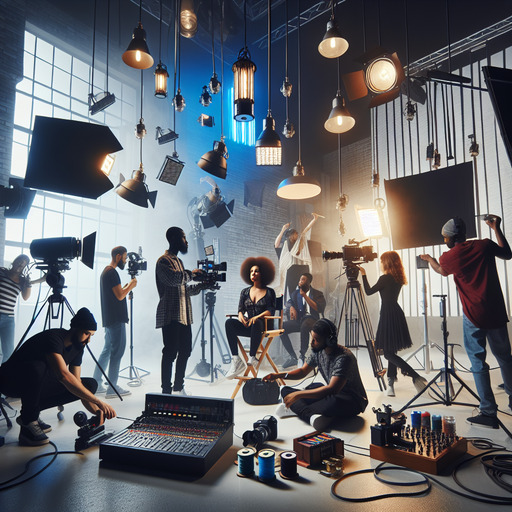
-
Table of Contents
Unlock the secrets to stunning music video production with expert lighting techniques! Elevate your visuals and captivate your audience. Learn more here.
Introduction
Music video production lighting techniques are essential for creating visually compelling and emotionally resonant content. Effective lighting can transform a simple scene into a dynamic visual experience, enhancing the narrative and mood of the music video. Key techniques include the use of natural light, artificial lighting setups, and creative lighting effects. Natural light can provide a soft, realistic look, while artificial lighting allows for greater control and creativity. Techniques such as three-point lighting, backlighting, and the use of colored gels can add depth, contrast, and atmosphere. Additionally, practical lights, such as lamps or neon signs, can be incorporated into the scene to create a more immersive environment. Mastery of these techniques enables directors and cinematographers to craft unique visual styles that complement the music and engage the audience.
Mastering Music Video Production Lighting Techniques for Cinematic Visuals
Mastering the art of music video production lighting is essential for creating cinematic visuals that captivate audiences and enhance the storytelling of the song. Lighting, often considered the backbone of visual aesthetics, plays a crucial role in setting the mood, highlighting key elements, and ensuring that the video looks polished and professional. To achieve this, one must understand various lighting techniques and how to apply them effectively.
To begin with, the importance of planning cannot be overstated. Before the cameras start rolling, it is vital to have a clear vision of the desired look and feel of the video. This involves collaborating with the director, cinematographer, and other key crew members to develop a lighting plan that aligns with the creative concept. By doing so, one can ensure that the lighting setup enhances the narrative and complements the overall visual style.
One fundamental technique in music video production lighting is the use of three-point lighting. This classic method involves three primary light sources: the key light, fill light, and backlight. The key light is the main source of illumination, typically positioned at a 45-degree angle to the subject, creating depth and dimension. The fill light, placed on the opposite side, softens shadows cast by the key light, ensuring that the subject is well-lit without harsh contrasts. The backlight, or rim light, is positioned behind the subject to create a subtle halo effect, which helps to separate the subject from the background and adds a sense of depth.
In addition to three-point lighting, understanding the use of color temperature is crucial. Different light sources emit varying color temperatures, measured in Kelvin (K). For instance, tungsten lights produce a warm, yellowish hue (around 3200K), while daylight-balanced lights emit a cooler, bluish tone (around 5600K). By carefully selecting and balancing these light sources, one can create a specific atmosphere that aligns with the video’s mood. For example, a warm, intimate scene may benefit from tungsten lighting, while a high-energy, outdoor performance might be best captured with daylight-balanced lights.
Moreover, the use of practical lights can add a layer of authenticity and creativity to a music video. Practical lights are visible light sources within the scene, such as lamps, neon signs, or even candles. These lights not only contribute to the overall illumination but also enhance the visual narrative by providing context and depth. When used thoughtfully, practical lights can create striking compositions and dynamic lighting effects that elevate the video’s aesthetic appeal.
Another advanced technique is the use of lighting modifiers, such as diffusers, reflectors, and gels. Diffusers soften the light, creating a more flattering and even illumination, which is particularly useful for close-up shots. Reflectors bounce light onto the subject, filling in shadows and adding a natural glow. Gels, on the other hand, are colored filters placed over lights to alter their hue. By experimenting with different gels, one can introduce vibrant colors and dramatic contrasts that enhance the visual storytelling.
Furthermore, the importance of lighting control cannot be overlooked. Tools such as dimmers, flags, and barn doors allow for precise manipulation of light intensity and direction. Dimmers enable gradual adjustments to light levels, ensuring that the illumination is just right for each shot. Flags and barn doors help to shape and direct the light, preventing unwanted spill and focusing the illumination where it is needed most.
In conclusion, mastering music video production lighting techniques requires a combination of technical knowledge, creative vision, and meticulous planning. By understanding and applying these techniques, one can create cinematic visuals that not only complement the music but also engage and captivate the audience. Through careful consideration of lighting setups, color temperatures, practical lights, modifiers, and control tools, one can achieve a professional and visually stunning music video that stands out in the competitive landscape of the industry.
Q&A
1. **Question:** What are some common lighting techniques used in music video production?
**Answer:** Common lighting techniques in music video production include:
– **Three-Point Lighting:** Utilizes key light, fill light, and back light to create a balanced and dynamic look.
– **Color Gels and Filters:** Used to add color to the lighting, creating mood and atmosphere.
– **Soft Lighting:** Achieved with softboxes or diffusers to create a gentle, flattering light.
– **Hard Lighting:** Uses direct, unfiltered light to create sharp shadows and high contrast.
– **Backlighting:** Illuminates the subject from behind to create a silhouette or halo effect.
– **Practical Lighting:** Incorporates existing light sources within the scene, like lamps or neon signs, for a natural look.
– **Spotlighting:** Focuses intense light on a specific area or subject to draw attention.
– **Strobe Lighting:** Provides a flashing effect, often used in dance or high-energy scenes.
– **LED Panels:** Versatile and adjustable lights that can change color and intensity easily.
– **Natural Lighting:** Utilizes sunlight or moonlight for an authentic and organic feel.